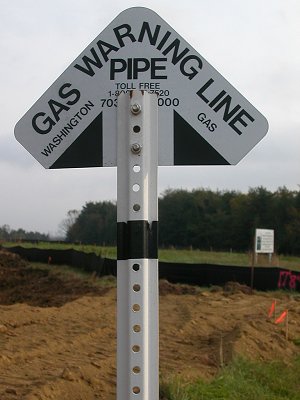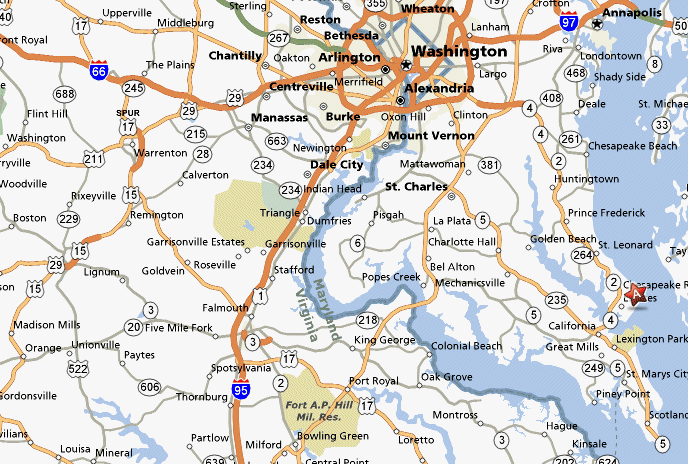How Does Fuel Get to Northern Virginia?
|
Fuel transport in Northern Virginia was very simple, until technological advances with oil, natural gas, and electricity complicated life about a century ago. Until after World War I, residents of Northern Virginia generated their energy on a very distributed - and sustainable - model.
In Native American society, the assumption is that each family unit gathered the amount of fuel they considered necessary to generate heat in an individual house. Each family had complete control over how much fuel was actually used each day. There was a clear feedback loop - if the family wanted more heat, someone in the family had to work harder to gather the fuel required to generate more heat. Cooking was done with the same fuel as heatring, though the cooking fire may have been outside the home.
Fuel was from a local source. After a few years, easy-to-gather wood would have been exhausted, and cutting large branches or whole trees with stone/bone tools was probably not a popular solution. Most history texts suggest Native Americans moved their towns every few years due to soil exhaustion - but a more important factor may have been the need to obtain firewood.
Small fires were kept burning constantly in individual houses, even during summer months. The smoke and heat kept bugs away, and kept the bark/reed building dry so mold would not grow. At mealtimes, additional fires would be used for cooking outside - equivalent to using modern "baseload" plants to provide steady heat plus "peaking" power plants at mealtimes today.
|

|
 The European settlers followed a similar pattern. Though much of the forest was cleared for agriculture, each farm retained a woodlot large enough to grow a renewed supply of energy to match whatever was used each year. Today, a few Northern Virginians still use wood stoves to provide auxiliary heat in their homes - though they may pay outrageous amounts of money for a "cord" of firewood that is supposed to be 128 cubic feet (4 feet long, 4 feet wide, and 8 feet high, ignoring air spaces between the logs).
The European settlers followed a similar pattern. Though much of the forest was cleared for agriculture, each farm retained a woodlot large enough to grow a renewed supply of energy to match whatever was used each year. Today, a few Northern Virginians still use wood stoves to provide auxiliary heat in their homes - though they may pay outrageous amounts of money for a "cord" of firewood that is supposed to be 128 cubic feet (4 feet long, 4 feet wide, and 8 feet high, ignoring air spaces between the logs).
Today, most Northern Virginia homes get their primary heat from fuel oil, natural gas, or electricity (baseboard heaters or heat pumps). In less than a century, we have altered our dwellings and our lifestyles dramatically. This ability to adjust is a source of encouragement to those who propose a major shift away from fossil fuels, in order to reduce global warming and increase reliance on domestic energy sources.
Today, fuel oil is delivered by pipelines from refineries in Texas/Louisiana to "tank farms," such as the one on Pickett Road near Route 236 in Fairfax. Most of these pipelines were built in just the last 75 years. Oil trucks are loaded at tank farms, then carry the fuel oil on local streets to small storage tanks at individual houses. Furnaces in indivudual houses burn the oil to generate heat. Production and refining is centralized, and transportation relies upon a fixed infrastructure to the tank farm. Storage occurs in regional tank farms and in tanks at individual houses. Final use of fuel oil for heat occurs at individual houses.
All this is "duh, obvious" to adults who live in Northern Virginia, but so obvious that we forget to note how much our modern energy transport and use is centralized vs. decentralized.
Natural gas is also used at individual houses, but distribution is different. While much of the fuel oil used in Northern Virginia is refined from imported crude at a few locations near the Gulf of Mexico (and there are refineries in New Jersey), most of the natural gas use in our area is produced in the United States or Canada. Importing gas from Algeria and other foreign sources requires liquifying the gas under pressure, then shipping it in vessels that are essentially giant thermos bottles to keep the gas in liquefied form. A Liquified Natural Gas (LNG) terminal is located at Cove Point, Maryland, near Calvert Cliffs. Pipelines do connect that source of imported gas to Northern Virginia, including to the Possum Point electricity generating plant near Dumfries.
Natural gas is piped directly to individual houses through a network of pipelines that stretch across the entire country. No natural gas trucks are used to deliver that particular fuel the "last mile" to the customer, because natural gas has a low energy-to-volume ratio. Fuel oil customers get a big bill once or twice a year when the oil is delivered to the local storage tank, but customers using natural gas simply turn on the furnace and draw the fuel from pipelines stretching across multiple states. The gas is stored in the pipes, waiting for the customer to request it.
 Cove Point - site of LNG terminal
Cove Point - site of LNG terminal
Source:
Mapquest
Electricity is an energy source with highly-centralized production, but a distribution network that dwarfs even the pipeline system for natural gas. Northern Virginia has several power plants generating electricity from coal and natural gas. The coal is shipped by rail, and gas is shipped by pipeline, to the Potomac River Generating Station in Alexandria (owned by Mirant), the Possum Point plant near Dumfries, and a few smaller facilities scattered around the region.
However, most electricity generated by Mirant is shipped into the District of Columbia through powerlines underneath the Potomac River. Electricity generated at Possum Point is intended to be shipped to Delaware and New York, once the new Mid-Atlantic Power Pathway Project powerline is constructed to carry the electricity across the Potomac River.
Northern Virginians now depend upon a few centralized power plants, burning fuels imported from far away and distributing energy through grid of wires to a wide range of energy users. Major fuels used to create electricity for our region are coal and nuclear, and we do not have those resources in Northern Virginia. So most electricity used in Northern Virginia is produced from outside the region and imported by powerline. The nuclear power plant at Lake Anna, southeast of Fredericksburg, is likely to expand from 2 to 4 reactors soon. That energy could be imported into Northern Virginia - or shipped all the way to customers in New York.
A grid of powerlines links electrical plants and customers. Distributing electricity is not the same as shipping widgets from a factory to a retail outlet - electricity generated at one plant does not always go to the same user. When customers turn a light switch, they can't identify the exact source of their electricity. Arlington County buys renewable energy credits ("green tags") equivalent to 3% of its electricity used by government agencies from a wind farm in West Virginia... but the power from that wind farm may never be transported into Northern Virginia. Instead, wind farm power is fed into the grid, and in theory a power plant using non-renewable sources will slow down a notch rather than burn an extra ton or two of coal.
A complicated set of industry and government organizations deal with the technological requirements to maintain voltage across the grid, and to ensure reliable service. Northern Virginia utilities are linked through a regional transmission organization known as PJM Interconnection. (Letters reflect its origins as a smaller organization - "P" for Pennsylvania, "J" for New Jersey, and "M" for Maryland... but now it has expanded.)
By joining the regional transmission organization, utlities gain the ability to purchase power from other suppliers and to sell Virginia electricity to external customers. Electricity generation was once a tightly regulated industry. Utilities such as Virginia Power (now Domninion Resources) and Northern Virginia Electrical Cooperative (NOVEC) were guarateed a certain profit (rate of return on capital invested), but were unable to compete.
Read:
The linkage of once-separate utility service areas, and the creation of a competitive market in for Northern Virginia power plants to generate and sell electricity at wholesale rates, requires a good understanding of the political environment as well as physical geography. Dominion Resources has one of the most effective lobby operations dealing with the General Assembly, and has been quite effective in getting legislation passed to facilitate the business operations of the company during the deregulation/re-regulation of electricity sales.
However, not everyone supported Dominion's proposal to join PJM Interconnection. Public Citizen expressed its opposition in 2004, noting that Virginia customers were at risk of voltage reductions ("brown-outs") if power generated in Virginia was exported out of state:1
- Dominion is thirsty for an export market for the electricity it generates, despite whatever consequences such generation might have for local authorities who want to maintain some measure of control over the utilities producing power in their districts. By joining PJM, Virginia will very likely become an exporter of power through Dominion, since the state’s electricity rates are cheaper than the
PJM average. Virginia’s retail electric rates are 5.5 percent lower than the PJM average (6.3 cents per kilowatt/hour versus 6.7 cents per KwH). Indeed, Virginia’s SCC has expressed wariness over the prospect of Virginia customers losing priority transmission service, which the FERC considers undue discrimination in a deregulated market. This situation has prompted the Richmond Times-Dispatch to question, "If, as the [FERC] suggests, states can pull no strings to protect their native load, then can PJM brown-out rate-paying Virginians to avert a blackout elsewhere?"
- (NOTE: FERC stands for Federal Energy Regulatory Commission, a Federal agency. SCC stands for State Corporation Commission, a state of Virginia agency that regulates utilities.)
References
1. Public Citizen, "Dominion Resources, Inc. - A Public Citizen Corporate Profile, October 2004", p.13, http://www.publiccitizen.org/documents/DominionCorpProfile04.pdf (last checked March 26, 2008)
Making NOVA Work: Energy and Waste Management
Northern Virginia
Virginia Places

 The European settlers followed a similar pattern. Though much of the forest was cleared for agriculture, each farm retained a woodlot large enough to grow a renewed supply of energy to match whatever was used each year. Today, a few Northern Virginians still use wood stoves to provide auxiliary heat in their homes - though they may pay outrageous amounts of money for a "cord" of firewood that is supposed to be 128 cubic feet (4 feet long, 4 feet wide, and 8 feet high, ignoring air spaces between the logs).
The European settlers followed a similar pattern. Though much of the forest was cleared for agriculture, each farm retained a woodlot large enough to grow a renewed supply of energy to match whatever was used each year. Today, a few Northern Virginians still use wood stoves to provide auxiliary heat in their homes - though they may pay outrageous amounts of money for a "cord" of firewood that is supposed to be 128 cubic feet (4 feet long, 4 feet wide, and 8 feet high, ignoring air spaces between the logs).
